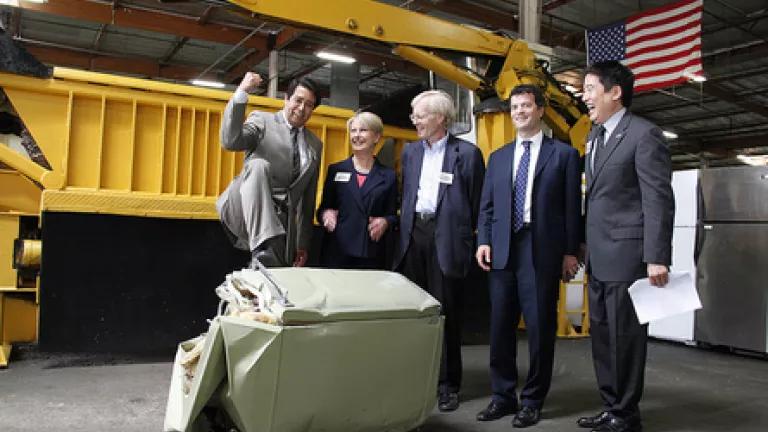
Southern California Edison Company recycled its one millionth refrigerator yesterday, a significant milestone that also exemplifies a spectacular national energy-savings success story.
The customer who donated the hideous avocado-colored electricity-guzzler from the 1970s received the customary $35 rebate from the utility and, like many other SCE consumers, promptly donated it to a program that provides weatherization services to low-income customers throughout Edison’s southern California territory.
SCE estimates removing 1 million inefficient refrigerators and freezers from the grid has saved:
- 7.9 billion kilowatt hours of electricity;
- $1 billion in energy costs; and
- avoided the emission of over 177,000 pounds of ozone-harming substances and 3.9 metric tons of carbon dioxide – the equivalent of planting 140 million trees, powering 1.1 million California homes for a year or removing 760,000 vehicles from the road.
From left to right: Gene Rodrigues, Lynda Ziegler, Ralph Cavanagh, Jared Blumenfeld, Erwin Furukawa (Photo credit: Southern California Edison).
The one-millionth inefficient clunker is being recycled at a plant that employs 40 people in a meticulously maintained industrial facility in Compton, a community that treasures these manufacturing jobs and takes pride in its environmental leadership.
The plant separates and prepares for reuse every plastic and metal refrigerator and freezer part, while also capturing and destroying the ozone-eating chlorofluorocarbons (CFCs) in the old appliances’ insulation and internal fluids. (Fortunately, CFCs are no longer used in new refrigerators).
I was in Compton to help recycle the avocado appliance, commemorate an NRDC-SCE partnership on energy efficiency that dates back more than three decades, and to note that the Compton plant is an important element of America’s remarkable energy savings progress.
Over the past 30 years, thanks to energy efficiency standards and policies that save consumers money and energy, we’ve dramatically reduced the electricity needs of new refrigerators – by more than three-fourths on average – while also cutting the costs of refrigeration by an equivalent amount. At the same time, we no longer have to be concerned that refrigerators are assaulting our ozone layer with CFCs.
But we don’t want the old ones ending up in garages or flea markets to be reused by someone else, which is why recycling programs like Edison’s are an important complement to the incentives and efficiency standards that have established a tradition of continuous improvement in refrigerator efficiency and performance.
Other California utilities offering refrigerator recycling programs include Anaheim Public Utilities, Burbank Water and Power, Glendale Water and Power, Los Angeles Department of Water and Power, Pasadena Water and Power, Riverside Public Utilities, and San Diego Gas and Electric.
But this story is hardly unique to refrigerators. Earlier this month the U.S. Department of Energy established efficiency standards for clothes washers and dishwashers that will cut their electricity and water use in half compared to averages for their counterparts from the 1990s. Last January, the nation began phasing in standards for light bulbs that will cut the electricity needs of the nation’s four billion sockets by more than two-thirds within eight years. Utilities like Edison have helped from the outset by rewarding customers, retailers and manufacturers for efficient product choices.
The light bulb standard, for example, would not have been possible without decades of utility incentives to improve on the incandescent light bulb invented 125 years ago by the man for whom Southern California Edison is named. The energy-savings upgrade of all light bulbs made or imported into the United States by 2020 will owe a lot to the one million energy-saving bulbs that SCE had installed by February of 1991 (a first for the utility industry) through a program providing free energy-saving bulbs to low-income households. And yes, there was a ceremony for that, too, where I applauded as proud owner Mary Martinez installed that 1 millionth bulb in her Rosemead, California, living room. She and the Compton workers are part of an efficiency trend that has helped the U.S. economy grow three-fold since 1970 while its energy needs grew at only one-sixth that pace.
If we want to sustain and accelerate that progress, we need to convert all our utilities to a business model that Southern California Edison long ago embraced. Regulators should act to ensure that utilities’ financial health is no longer tied to increases in electricity and natural gas use at a time when we need to be using less of these resources. All investor-owned utilities like Edison should have opportunities to increase their earnings based on energy-efficiency performance.
If this sounds like good common sense, it’s sobering to realize that not all of our utilities have joined Edison in taking advantage of these opportunities to promote energy efficiency, in part because many of them are still chained unnecessarily to business models that tie their financial health to higher electricity and natural gas sales.
But programs like Edison's to recycle inefficient appliances are a good first step in drawing attention to the fact that energy efficiency is our cheapest and cleanest energy resource.
